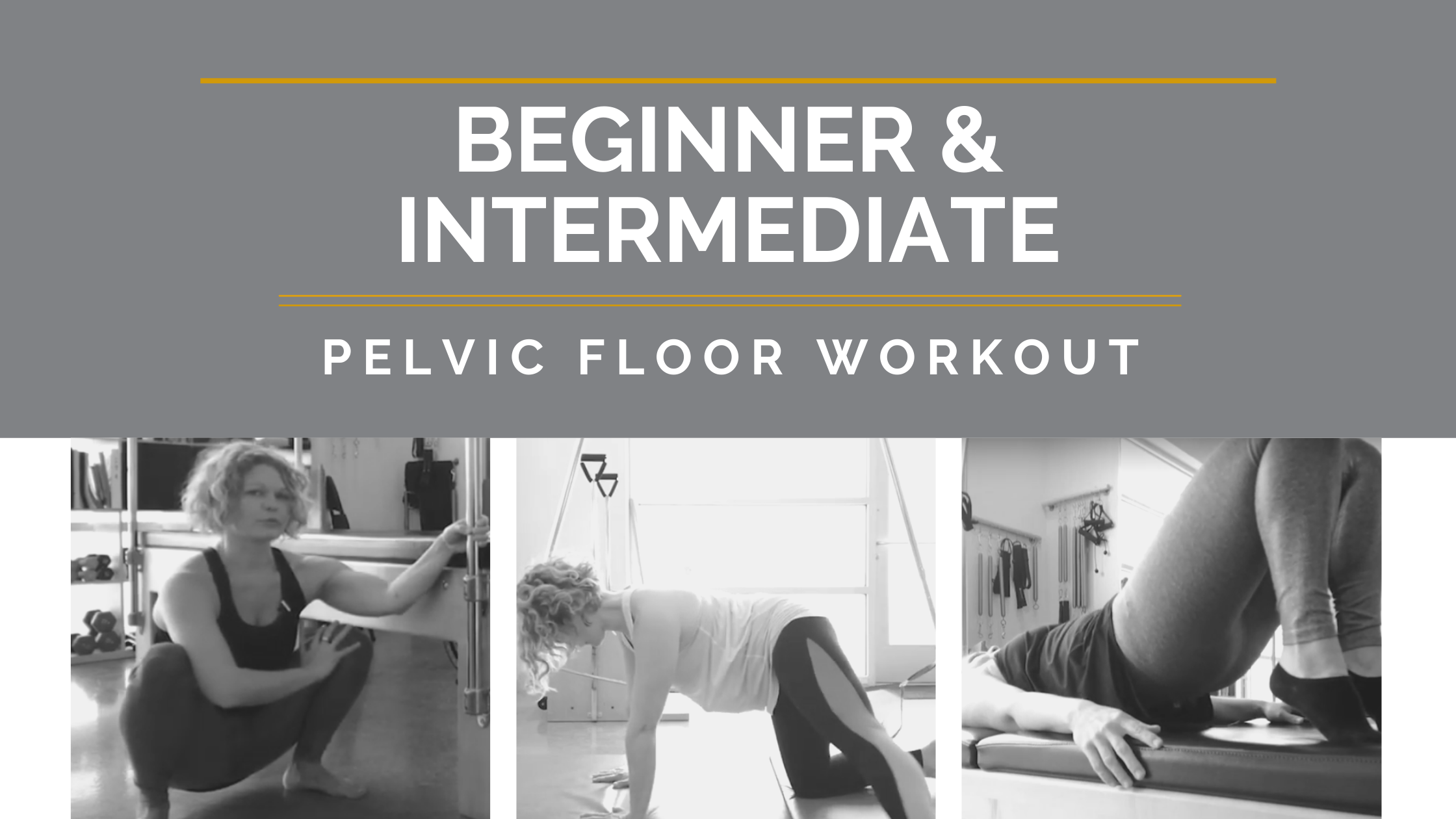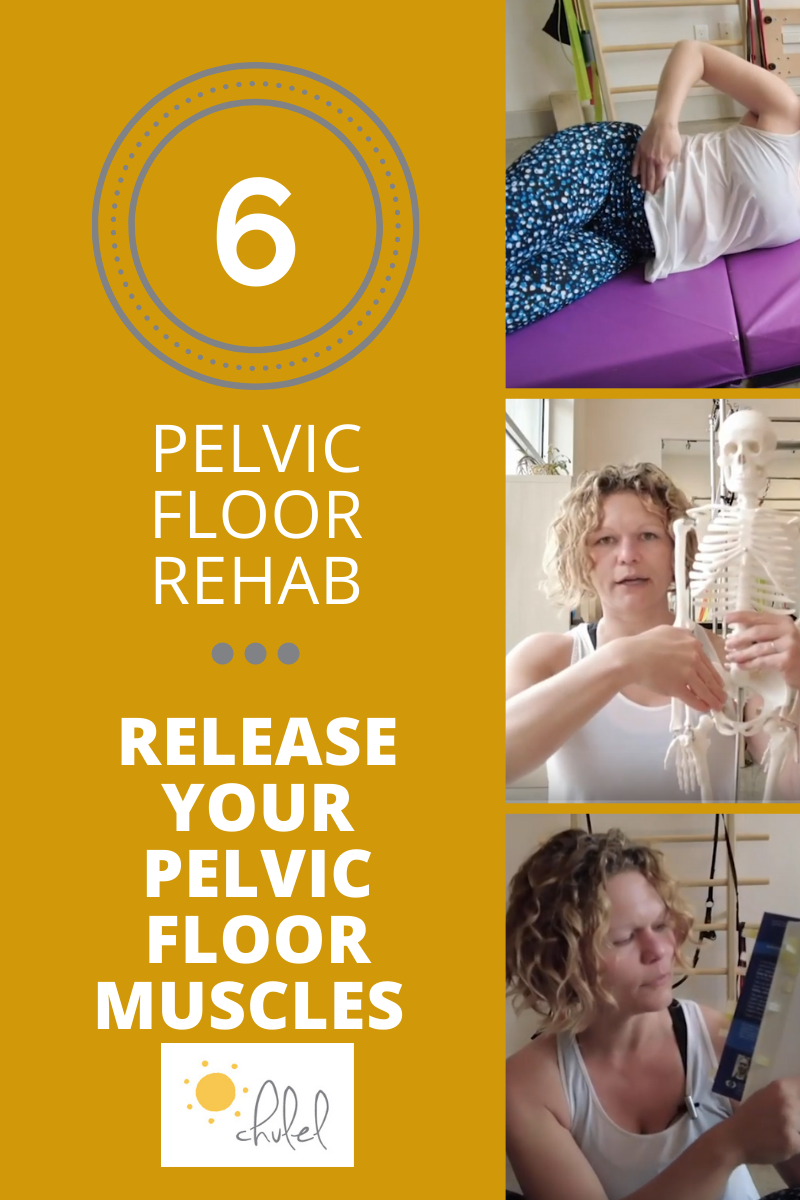Your Custom Text Here
Pelvic Floor Rehab-Beginner & Intermediate Workouts
Now that we have massaged/stretched/turned on all of the things, it’s time to do some coordinated movement.
This beginner workout video is targeted to those recently in pain or currently in pain. It’s a series of gentle, mindful movements to connect these areas we’ve covered in the course and start to build some basic strength connections. We start with some cat/cow, thinking about it from your pelvic floor over just the breath or what the spine is doing. Then, we do a series of exercises to connect your legs into the fascial line of the pelvic floor, closely mirroring what should happen as you walk. We then migrate up into glute and hamstring strength, combining it with some ankle work. Our grand finale is a 1 minute squat, focusing on relaxing and releasing the pelvic floor and then pulling up energetically for some grounding work.
In the intermediate workout, we start with various exercises with the legs in a diamond shape to target the inner and outer thighs. Have a 12 inch ball or foam roller and a towel/yoga strap nearly. We then move to some hip exercises weight-bearing in the arms for a bit of a stability challenge. Then, using a towel or yoga strap, we do an exercise to isolate the adductors/inner thighs. We wrap up the workout with a series of squats to work the thighs and ankles as well as the pelvic floor.
Pelvic Floor Rehab-Release Pelvic Floor Muscles & How to Activate the Pelvic Floor
We’re finally into the meat! In this video we go over how to release SUPER common problem spots for pelvic pain and lower back pain—the pesky pectineus, iliacus and obterators.
You can use just your hands to get some relaxation in these areas and they do *wonders* for relieving pain all over the body, including the neck and shoulders.
To release the pectineus, you’ll want to pin the pocket of the groin, and then you can use the weight of your leg to act as a stretch. In massage it’s called a ‘pin and stretch’. I go over the details in this video—promise you’ll feel like your leg not only gets longer, but more relaxed afterward.
The iliacus lines the ilia of the pelvis and can be a major core compensation muscle. This muscle can be tight if you also have digestive issues or hold tension in your ‘guts’. Releasing this before attempting core work may help you get more abdominal engagement.
Lastly, we go into the obterators, which are super deep at the base of the pelvis. These get tight from sitting as well as from breath-holding. Many of us also ‘pinch pennies’ down there when we’re stressed, which makes this area chronically tight. Think about the pelvis like a butterfly with its wings spread. Pinching the bottom of the wings together pulls the upper wings apart. Thus, releasing that tether on the bottom wings, relaxes the upper portions. Doing this can be a huge help in lower back pain.
I would not suggest using something like a Theragun on this area—you aren’t trying to pummel your pelvic muscles. This massager has some helpful attachments that help to hook onto bones and it has a vibrational/percussive element instead of just percussive. Also, if you gently try to push those upper edges of the butterfly wings (the ilia) together and that feels relaxing to your body, you may want to invest in a pelvic floor belt. There’s a lot of variety here and you want to find the right thickness for you as if you buy one that has too much depth, it will ride up as you bend over. Here’s the one I’ve heard the best feedback on from clients. You can find my favorite book on the pelvic floor with helpful exercises here.
Again, massaging these spots will help you relax all over and will make it easier to breathe. Please comment or reach out if you have any questions and thanks for watching!
Pelvic Floor Rehab-Feet & Ankles
Foot and ankle tension, weakness and inflexibility can be a huge piece of pelvic and hip pain. If your gait pattern, how you walk and take a step, is compromised on one side, it very often reverberates up the chain into knee, hip and/or lower back pain. So what do we do about it?
Loosening the Feet
There are some simple products that can help here in addition to your hands.
If you want to go all in, this foot massager is lovely. It’s around $100 and it has a heat function. Visualize warm foot rubs in increments of 15 minutes with coffee/tea in hand. My personal favorite is 2 sessions in a row. I have felt like my own gait pattern is normalizing as I do this and then go for a conscious walk.
Trigger point releasers for the feet. I own 2 pairs of these (one that is 10 years old that I have in the studio, so these are durable). This is a newer version that I have personally not tried, but seems similar and is about half of the price of the ones I own.
Yoga toes for stretching out the feet. You can also use those inserts they give you after a pedicure. Or, put your fingers in between your toes and move your ankle around.
Here is a self-massage. There’s another version I do in the video on this page.
Loosening the Ankles
Using a towel or a theraband, you can stretch out the back of your ankles (read: calves). There’s also a version in this video where I combine down dog with a front of ankle stretch—no props needed. That said, this calf boot stretcher is a game changer and I highly recommend the investment. You can stretch the calves and shins using it. This is another case where I own 2—one for home and another for studio.
Rocking your body side-to-side helps work the lateral stability of the ankles. You can also invert/evert your ankle as you stretch it with a band.
Strengthening the Feet & Ankles
In the featured video, I show a simple arch and dorsiflexor exercise. I also demo a simple way to work your foot inverters/everters. You could add resistance with a theraband or resistance band.
There’s also an explanation of 3 versions of a calf raise and how the ankles connect into the pelvic floor muscles. I find this prop to be super helpful to get the right muscles deep in the calves to work and/or place it up at the base of the spine for loose pelvic floors to get those muscles to lift. It’s not on Prime, but it’s seriously the best size and density ball I’ve ever found for this.
Having supple feet and strong ankles is a huge part of aging well. The image I always give here is that of a ballerina. All that strength comes through the foot and is a huge part of the solid core engagement of a dancer. As we age, folks tend to waddle, which is an easy tip over into breaking something. Take care of your feet and ankles and walk sexy!
Purchasing from the links listed on this page helps support my small, woman-owned business.
FREE Pelvic Floor Rehab Course
What is the pelvic floor?
I define the pelvic floor as more than just the elimination muscles—I see it as anything that touches brief underwear lines. If you think about it, those are in contact with a chair for hours a day (for the average person), so they atrophy over time. Then as we age we’re dumbfounded as to why it can be challenging to do day-to-day tasks like squatting down, lifting things off of the floor, getting up off of the floor or even balancing.
I don’t see stand up desks as a cure all for this. I’ve worked on many people with pelvic floor issues who use standing desks. Chances are you were sitting for years professionally or in school before you started using one. So, those imbalances can already be there.
Why is pelvic health important?
These are your falling-and-I-can’t-get-up muscles! They’re critical for aging well and having solid balance and stability. And, they’re often small muscles, so just because you work out, doesn’t necessarily mean that they’re one and strong.
It’s also critical to have good strength here for proper elimination long-term and to head off pelvic organ prolapse and prostate issues.
The pelvic floor also plays a critical role with the breath. Belly breathing is great for relaxation and yogic techniques, but the bandas have to relax and expand for true health in the pelvis. So, I find that a LOT of people need to work on expanding the pelvic floor, yes even moms, because their pelvic floors are tight from improper breathing. For this reason, pelvic floor health and strength isn’t just a postpartum or post-hysterectomy issue, it’s for men and women.
Structure and format of this course
This is not a course on Kegels! I find Kegels to be a constipation view of pelvic floor health and not encouraging dynamic strength that we need there to do things like lifting and balancing.
We’ll start distal (away) from the pelvis and work our way in. We’ll look at common, faulty neuromuscular pathways I’ve seen over the last decade and try to correct those patterns. The modules will have a release then stretch then re-engage format and then I’ll also include some basic as well as intermediate exercise sequences. At that point, you’re free to go about your way in a regular exercise class, hopefully with these areas more engaged.
Why I’m passionate about this content
You can find out more about this in my bio. Long story short, I had an intense and painful bout of piriformis syndrome for about a year and a half after my dad unexpectedly passed away. Thing is, it never got diagnosed as such. I was super active and 28 at the time. MRI came back negative for disc issues and every doctor kept wanting to label it as sciatica, which it wasn’t. After thousands spent on physical therapy/massage/chiropractic/acupuncture, I started studying anatomy and biomechanics and figured out it was the piriformis. I looked up ‘piriformis problems’ and the web said it was common for people who ran a lot and who sat at a desk for a living. That was me to a T!
Thing is, the pain didn’t get better with just the biomechanics. The holistic folks kept saying it was my internalized grief. I was crying all the time, so I didn’t see anything internalized about it. That said, the more I dug into the deeper feelings about how my dad died, the pain started to change. This is why I bring this approach into my work with clients. If something has stuck around for months or years, there’s a good chance you’re holding some deeper stress and emotions around it. I’ll bring in some of the things I’ve researched over the years re:emotions and the pelvis into this course as well.
Another reason why pelvic health is so important to me…my grandmother has had chronic UTIs for 25 years. At this point, she’s pretty much immune to all antibiotics. I can’t help but think if she started doing things like this in her 50s and 60s she wouldn’t have suffered so much and have this risk in her 80s.
Internal pelvic floor physical therapists in Austin
This course is not meant to be a substitute for proper, internal physical therapy. In Texas, you typically need a doctor referral. Here are some of my favorite folks in Austin.








